New US coronavirus cases have risen sharply in recent weeks, leading investors to worry that renewed lockdowns will again depress economic activity. But since the first infection wave in March and April, it has become clear that broad lockdowns are not the only way to lower virus transmission, and many governments have started to require the wearing of face masks in public settings. Should the United States follow suit with a national mandate? This is inherently a political decision, but we can use our analytical tools to answer three questions that are relevant to it. First, how effective is a face mask mandate in increasing face mask usage? Second, does increased face mask usage lower virus transmission, and if so by how much? And third, how economically valuable is a face mask mandate in terms of reducing the need for broad lockdowns with their well-documented negative effects on GDP?
VIEW VIDEO: Jan Hatzius, head of Goldman Sachs Research and the firm’s chief economist, explores the link between face masks and coronavirus outcomes, and the economic value of a national face mask mandate in reducing the need for broad lockdowns.
- The sharp increase in confirmed coronavirus cases in the US Sun Belt has led investors to worry about renewed broad lockdowns with large negative effects on GDP. But there are also other ways to reduce infections, including stringent bans on large gatherings and greater use of face masks.
- In particular, we argue that a national face mask mandate could partially substitute for renewed lockdowns. We start by showing that a national mandate would likely increase face mask usage meaningfully, especially in states such as Florida and Texas where masks remain largely voluntary to date.
- We then investigate the link between face masks and coronavirus outcomes. Our analysis includes 1) a US regional panel in which we relate the growth rate of infections and fatalities to the introduction of state face mask mandates, 2) a large country-level cross section in which we relate cumulative infections and fatalities to the lag between the onset of spread and the introduction of a face mask mandate, and 3) a smaller country-level panel in which we relate the growth rate of infections and fatalities to lagged mask usage.
- We find that face masks are associated with significantly better coronavirus outcomes. Since this is true across all three of our models and the results are robust to the inclusion of a number of control variables, it seems to reflect a largely causal impact of masks rather than correlation with other factors (such as reduced mobility or avoidance of large gatherings). Our baseline estimate is that a national mandate could raise the percentage of people who wear masks by 15pp and cut the daily growth rate of confirmed cases by 1.0pp to 0.6%.
- Finally, we translate our results into GDP terms by asking how much our Effective Lockdown Index (ELI) would need to increase in order to cut infections by as much as a national mask mandate, and then converting the ELI impact into a GDP impact using the estimated cross-country relationship between the two. These calculations imply that a face mask mandate could potentially substitute for lockdowns that would otherwise subtract nearly 5% from GDP.
Face Masks and GDP [1]
New US coronavirus cases have risen sharply in recent weeks, with most of the deterioration concentrated in the “Sun Belt,” including Florida, Texas, Arizona, and California. This has led investors to worry that renewed lockdowns will again depress economic activity. By our estimates, the increase in our Effective Lockdown Index (ELI)—a combination of official restrictions and actual social distancing data—subtracted 17% from US GDP between January and April, and other countries with even more aggressive restrictions saw even larger economic effects.
Since the first infection wave in March and April, however, it has become clear that broad lockdowns are not the only way to lower virus transmission significantly. For one thing, public health experts have long believed that bans on large gatherings can bring disproportionate benefits. This belief has only grown with a multitude of studies documenting the importance of “super spreader” events, such as those associated with the Shinjeonji Church in South Korea, the Austrian ski resort Ischgl, various European soccer matches, and the celebrations in New Orleans for Mardi Gras.
A more abrupt shift has occurred in the official view on face masks. As late as March 30, the World Health Organization advised that there was “no specific evidence to suggest that the wearing of masks by the mass population has any potential benefit.”[2] Since then, however, the public health community's thinking has changed dramatically and many governments have started to require the wearing of face masks.
Should the United States follow these countries and adopt a national face mask mandate? This is inherently a political decision, but we can use our analytical tools to answer three questions that are relevant to it. First, how effective is a face mask mandate in increasing face mask usage? Second, does increased face mask usage lower virus transmission, and if so by how much? And third, how economically valuable is a face mask mandate in terms of reducing the need for broad lockdowns with their well-documented negative effects on GDP?
Face Mask Mandates and Usage
At present, the United States is among the less restrictive countries with respect to face mask mandates. The federal government did issue a national “recommendation” to wear masks in public settings in April, and many state and local governments have taken more stringent measures. However, a recommendation is not a mandate and the governors of both Florida and Texas—the two most heavily affected large states—recently reiterated their opposition to a statewide mask mandate. By contrast, many European countries now have national mask mandates in place, as shown in Exhibit 1, and much of East Asia has strong social norms of mask wearing when sick and during pandemics.
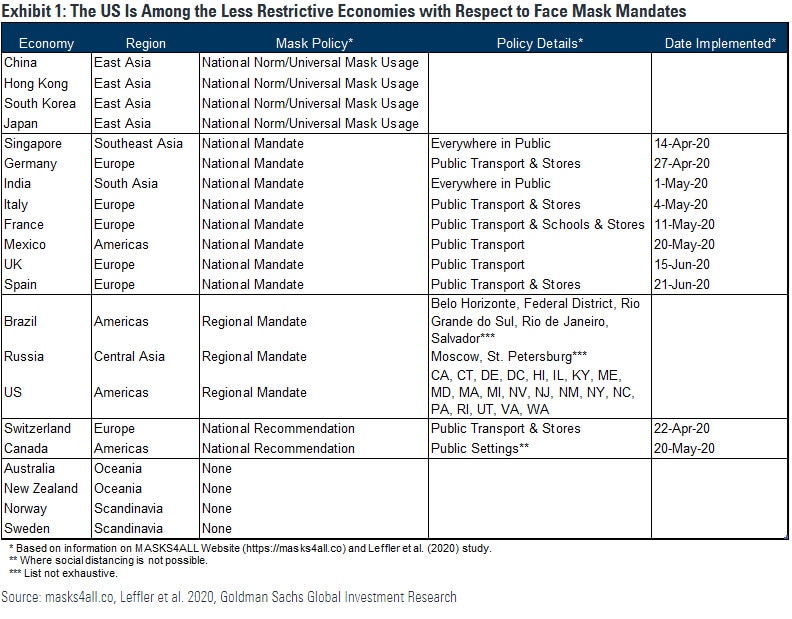
What about actual mask usage? In this respect, the US scores somewhat better than one might expect, at least when looking at the national self-reported average. As shown in Exhibit 2, the share of respondents saying that they wear a face mask in public is nearly 90% in East Asia, 80% in Southern Europe, just below 70% in the US and Germany, 30% in the UK, and as low as 10% in Scandinavia. Most countries, including the US, have seen large increases in self-reported mask usage since the start of the pandemic.
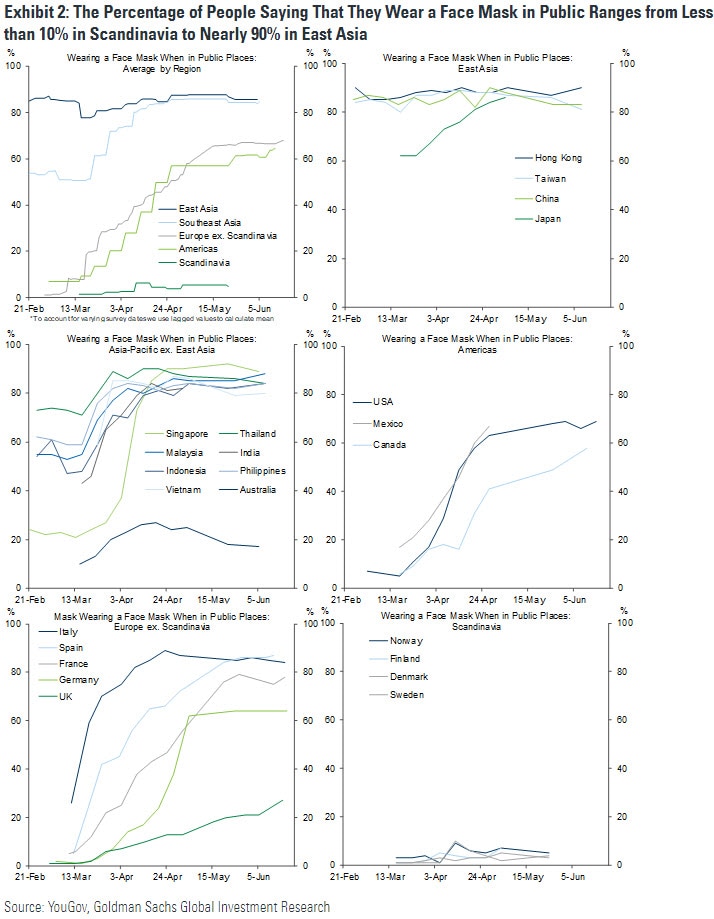
However, the national data don't tell the full story. As shown in Exhibit 3, face mask usage is highest in the Northeast, where the virus situation has improved dramatically in recent months, and generally lower in the South, where the numbers have deteriorated.[3] For example, only about 40% of respondents in Arizona say that they “always” wear face masks in public, compared with nearly 80% in Massachusetts.
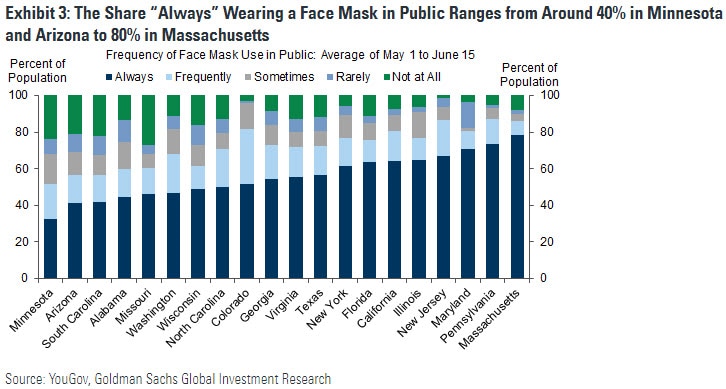
How effective would a national mask mandate be in pushing mask usage to Southern European or East Asian levels? To investigate this, we turn to a statistical event study that relates the adoption of mask mandates across US states to subsequent changes in self-reported mask usage.
We analyze the impact of face mask mandates issued by 20 US states plus DC between April 8 and June 24 in a state panel. We collect the announcement dates of mask mandates from a study in Health Affairs by Wei Lyu and George Wehby and construct statewide time series of face mask usage outside the home using YouGov Covid-19 Behaviour Tracker respondent-level data. We regress state-level mask usage on various event time dummies around the announcement and include state fixed effects and time fixed effects.[4]
Exhibit 4 shows our estimates of a large and highly significant impact of mandates on mask usage. We estimate that statewide mask mandates gradually raise the percentage of people who “always” or “frequently” wear masks by around 25pp in the 30+ days after signing (left panel). The percent of respondents who “always” wear masks rises by nearly 40pp 30+ days after, reflecting some people switching from “frequently” and other categories to “always” (right panel).
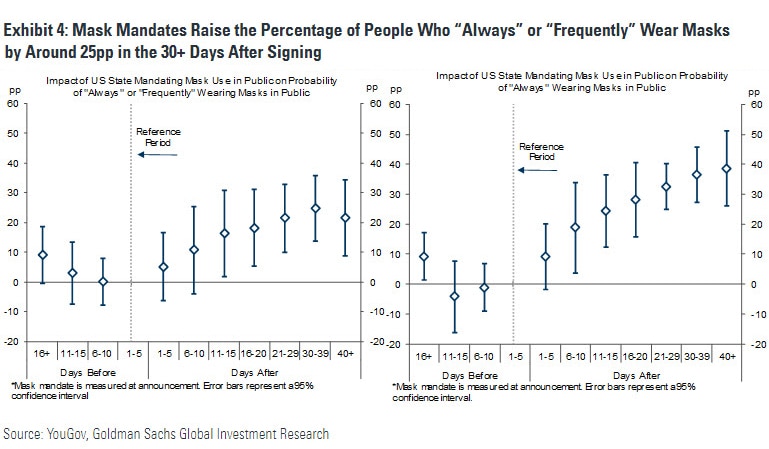
Exhibit 4 suggests that a national mask mandate could increase US face mask usage by statistically significant and economically large amounts, especially in states such as Florida and Texas that currently don’t have a comprehensive mandate and are seeing some of the worst outbreaks. Specifically, we estimate that a national mandate would increase the national average share of people who “always” or “frequently” wear masks by 15pp. This estimate is based on two assumptions. First, we assume that states that currently don’t have a mandate—which account for 50% of the population—experience a 25pp rise in mask usage in line with the average response to statewide mandates. Second, we assume that states which already have a state mandate see a 5pp increase in mask usage because of increased focus on the issue.
Face Masks and Virus Outcomes
Approach 1: US County Panel
Does increased face mask usage lower virus transmission, and if so by how much? To investigate this, we turn to three statistical approaches relating face mask usage and mandates to virus spread and fatalities.
Our first approach extends our event study analysis of US state-level mandates to the impact on the growth rate of infections and fatalities. Specifically, we regress county-level growth rates of infections and fatalities on event time dummies around the announcement and control for state fixed effects, time fixed effects, and a rich set of county-level controls.[5]
As shown in Exhibit 5, we estimate that face mask mandates have large and highly statistically significant effects on health outcomes. Our estimates imply that mask mandates lower the infection growth rate by 1.3pp in the 11-15 days after announcement. Relative to the 5.4% average infection growth rate prior to announcement, the growth rate of infections is cut by 25%. We also estimate significant and somewhat larger declines in the growth rate of COVID-19 fatalities of 2.4pp in the 11-15 days after announcement and of 3.7pp in the 21-29 days after.
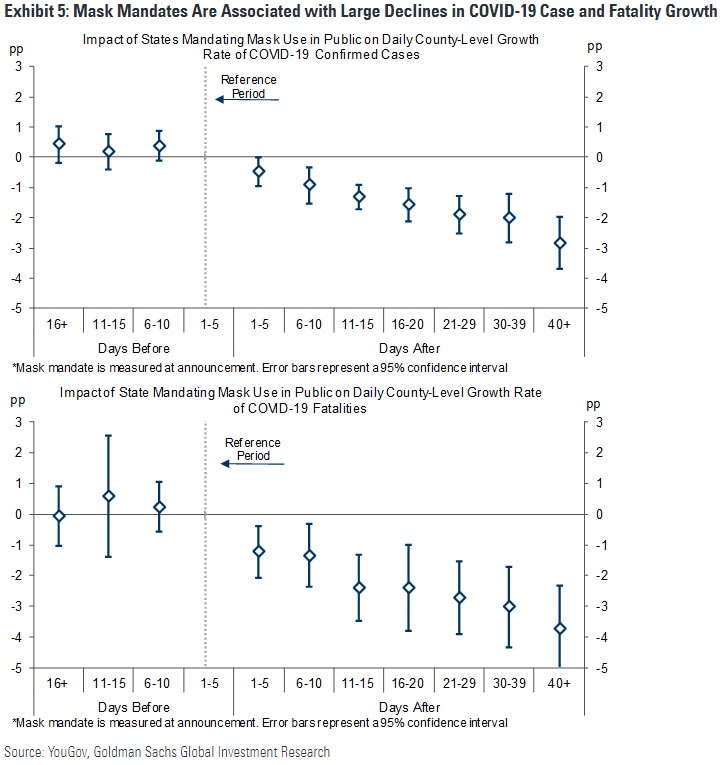
Approach 2: Large Country Cross-Section
Our second approach is a large country cross section in which we relate cumulative case counts and fatalities to the lag between the onset of spread and the introduction of a face mask mandate, building on a study by Christopher Leffler and co-authors.
Exhibit 6 presents the descriptive relationships graphically by plotting the length of the outbreak before masks were widely adopted against cumulative cases per capita (left panel) and cumulative fatalities per capita (right panel). We measure the start of the outbreak as the day of the first fatality. Both graphs show a positive and statistically significant slope, indicating that countries which took longer to reach widespread mask usage (whether by policy or cultural norms) suffered more virus cases and fatalities. The better fit for fatalities than cases likely reflects the relatively better measurement of fatalities.
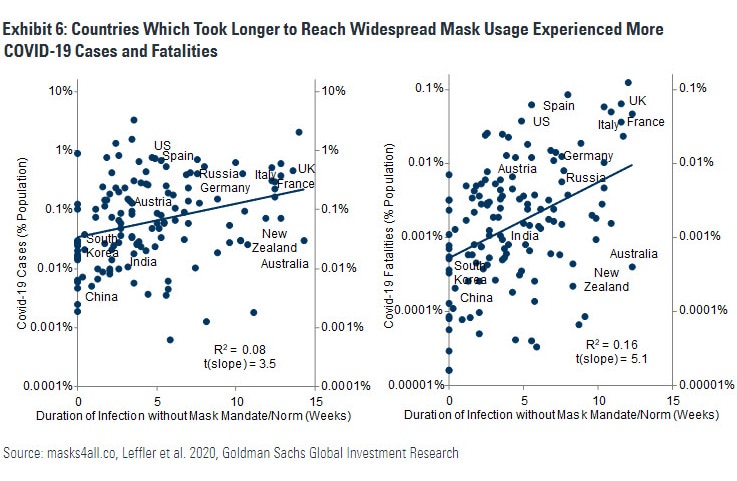
To formalize this finding, Exhibit 7 presents cross-sectional regression models of log cases and log fatalities for around 125 countries. In both regressions, we find statistically significant negative effects of masks on cumulative cases and fatalities after including controls such as the obesity rate, population density, age structure, and testing policy. Our numerical estimates are that cumulative cases grow 17.3% per week without a mask mandate but only 7.3% with a mask mandate, and that cumulative fatalities grow 29% per week without a mask mandate but only 16% with a mask mandate.
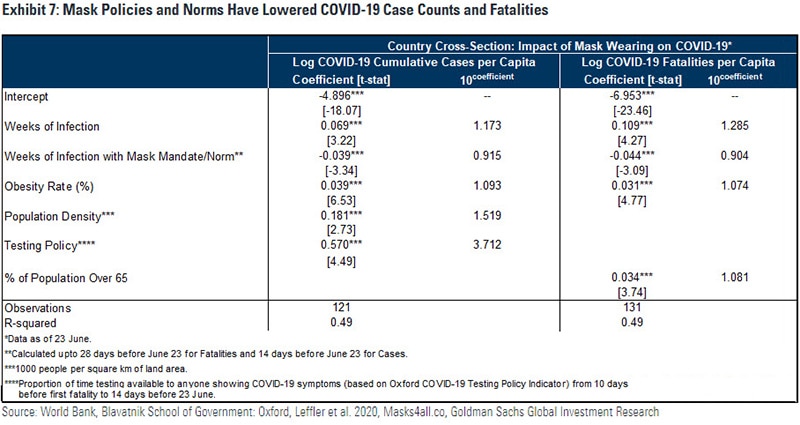
Approach 3: Country Panel
Our third approach consists of a smaller country panel in which we relate the daily growth rate of infections and fatalities to lagged self-reported mask usage, plus a number of control variables. There are three main results, illustrated in Exhibit 8.
First, face masks have a large negative impact on infections and fatalities, controlling for population density and income inequality (columns 1 and 4). This negative and significant impact of face masks is robust to controlling for our Effective Lockdown Index (ELI), the share of the population that say they avoid crowded public places (columns 2 and 5), and country and time fixed effects (columns 3 and 6). Our estimates suggest that a 25pp increase in the self-reported mask usage, for instance as a result of a mask mandate, lowers the growth rate of cumulative cases by 1.9pp and the growth rate of cumulative fatalities by 0.8pp.[6]
Second, the share of respondents that avoid crowded public places also has a large and highly significant negative impact on infections and fatalities. This not only suggests a significant role for “super spreader” events, but also strengthens our main results because it implies that the face mask result is not just driven by the correlation between face masks and other risky activities.
Third, the virus impact of mask usage is large, not just in absolute terms but also relative to the effect of economically costly shutdowns (as measured by our ELI). In fact, the coefficients on the percentage of self-reported mask usage are slightly bigger than those on the ELI, which is interesting as both variables are on a 0-100 scale.
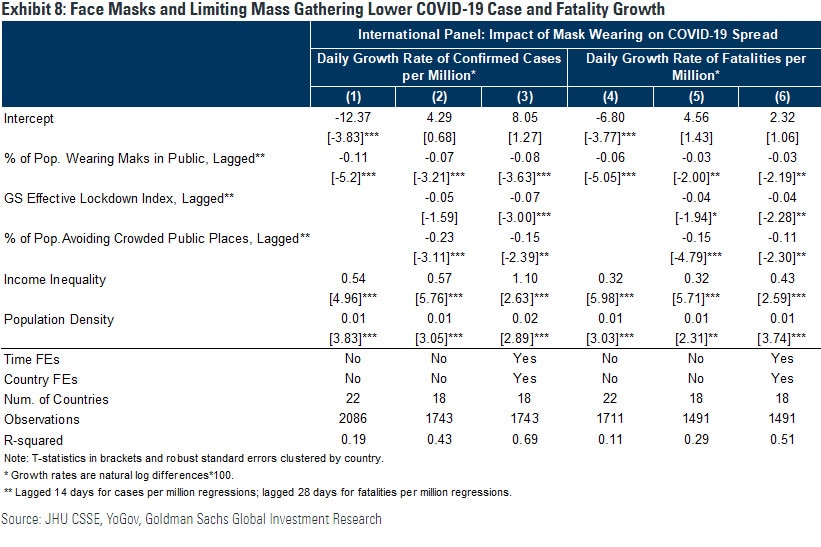
The Impact of a Mandate on Infections
Before we translate our statistical results into a baseline estimate of the impact of face mask mandates on virus outcomes, we need to address two potential concerns about our analysis up front.
The first concern is that the correlation between face masks and virus outcomes might reflect the effect of other unobserved forms of cautious behavior that are correlated with mask mandates or usage, instead of a truly causal effect of masks. But there are some reasons to believe that this type of bias in not a big issue for our analysis. Not only do we obtain remarkably similar estimates across our three approaches, but we also control for a number of other observable forms of cautious behavior. Specifically, our cross-country results on masks include our Effective Lockdown Index among the explanatory variables, and they are largely unchanged when we include the share of respondents who say they stay home from work, don't touch objects, improve personal hygiene, avoid contact with tourists, avoid raw meat, and don't send their children to school.[7]
The second potential concern is that our main results are based on confirmed infections, which can be distorted by a lack of testing. However, it is important to note that this would, if anything, lead to an understatement of the effect assuming that increases in testing are positively correlated with increases in mask usage. Moreover, we control for testing regime indicators in our cross-sectional regression, and we obtain generally similar estimates for fatalities—which are better measured—across all three of our approaches.
So what is a reasonable baseline estimate of the impact of a US national mask mandate on the growth rate of confirmed infections? To generate such an estimate, we apply our country panel results separately to two groups of US states, namely ones with and without a state-level mask mandate in place.
States that currently don’t have a state-level mandate account for 40% of US total confirmed cases, 45% of US GDP, half of the population, and two-thirds of new infections. This group has also experienced an average daily growth rate in confirmed infections of 2.9% in the past 7 days. Based on our analysis of state-level mandates, we estimate that a national mask mandate would raise mask usage by 25pp in these states. Our country panel shows that a 25pp increase in self-reported mask usage lowers the infection growth rate by 1.9pp (or just over 60%). The national mandate could therefore lower the daily growth rate in the group of states without a mandate from 2.9% to just over 1%.
States that currently do have a mandate have experienced a lower average daily growth rate in confirmed infections of 0.8% in the past 7 days. Combined with our assumption that a national mandate would lead to a smaller increase in mask usage of 5pp through extra awareness in this group of states, our country panel suggests a 0.4pp decline in the infection growth rate to 0.4-0.5%.
Combining the estimates for these two groups of states, we estimate that a national mandate could cut the national average growth rate of infections by nearly 1.0pp to 0.6-0.7%.
The Impact of a Mandate on GDP
If a face mask mandate meaningfully lowers coronavirus infections, it could be valuable not only from a public health perspective but also from an economic perspective because it could substitute for renewed lockdowns that would otherwise hit GDP.
How big is this potential effect? To generate an answer, we proceed in two steps. First, we use our cross-country panel analysis to ask how much our effective lockdown index (ELI) would need to increase in order to lower the daily case growth rate by 1.0pp, i.e. the estimated impact of a national face mask mandate. The answer is an increase in our ELI of 16pp.
Second, we ask how much a 16pp ELI increase would subtract from the level of GDP. As shown in Exhibit 9, the cross-country relationship implies that such an increase might reduce GDP by just under 5%.
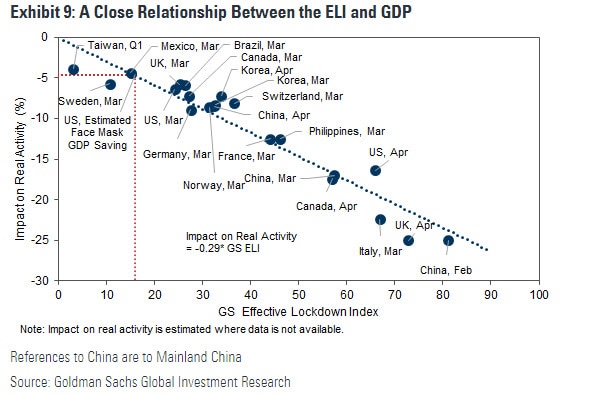
Thus, the upshot of our analysis is that a national face mask mandate could potentially substitute for renewed lockdowns that would otherwise subtract nearly 5% from GDP. It is important to recognize that this estimate is quite uncertain because it is based on a number of statistical relationships that are all measured with error. Despite the numerical uncertainty, however, our analysis suggests that the economic benefit from a face mask mandate and increased face mask usage could be sizable.
So will the US adopt a national face mask mandate? This is uncertain, partly because masks have become such a politically and culturally charged issue. However, even in the absence of a national mandate, state and local authorities might well broaden mandates in ways that ultimately mimic the impact of a national mandate. Either way, our analysis suggests that the economy could benefit significantly from such moves, especially when compared with the alternative of a return to broader lockdowns.
Jan Hatzius
Daan Struyven
Isabella Rosenberg
1 We thank Sid Bhushan and Dan Milo for valuable help with this report.
2 See Jaqueline Howard, “WHO stands by recommendation to not wear masks if you are not sick,” CNN, March 30, 2020.
3 As an aside, note that Minnesota has the lowest self-reported rate of mask usage among larger states in the US. This is interesting because the state is home to a large population of Scandinavian-Americans and Scandinavia has some of the lowest rates of face mask usage in the world.
4 Our mask usage regressions are weighted by state population, focus on states with more than 4 million people (given the small samples in the respondent-level data) and use robust standard errors at the state level. Our sample starts on April 2nd when respondent-level data become available. We also control for cumulative cases per million and cumulative deaths per million.
5 The county-level controls are population density, median house value, median household income, homeownership, pollution, maximum summer temperature, and maximum winter temperature, educational attainment, mean Body Mass Index, and the share of population over 65. We use county population weights and cluster robust standard errors at the state level. Our sample covers 2,373 counties and extends from March 31 to June 24. See Lyu and Wehby (2020).
6 Relative to the sample average growth rates of 3.8% and 2.8%, these estimates imply that a mask mandate raising mask usage by 25pp cuts the growth rates of infections and fatalities by nearly one half and one quarter respectively.
7 The cross-country panel and cross-county panel results are also robust to controlling for the lagged levels of fatalities and infections per capita, which helps address the concern that the mask effects pick up the impact of other forms of unobserved cautious behavior in response to the size of the outbreak.
Investors should consider this report as only a single factor in making their investment decision. For Reg AC certification and other important disclosures, see the Disclosure Appendix, or go to www.gs.com/research/hedge.html.

